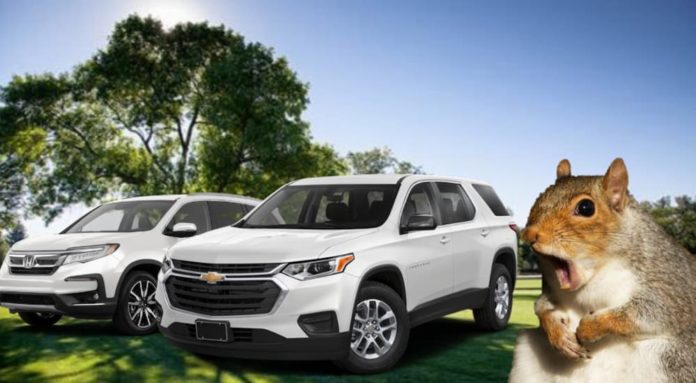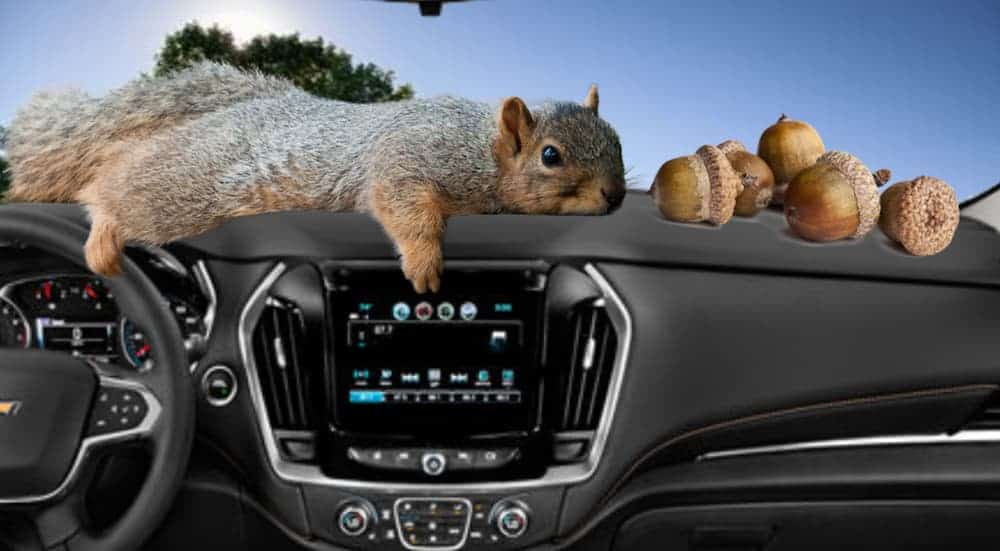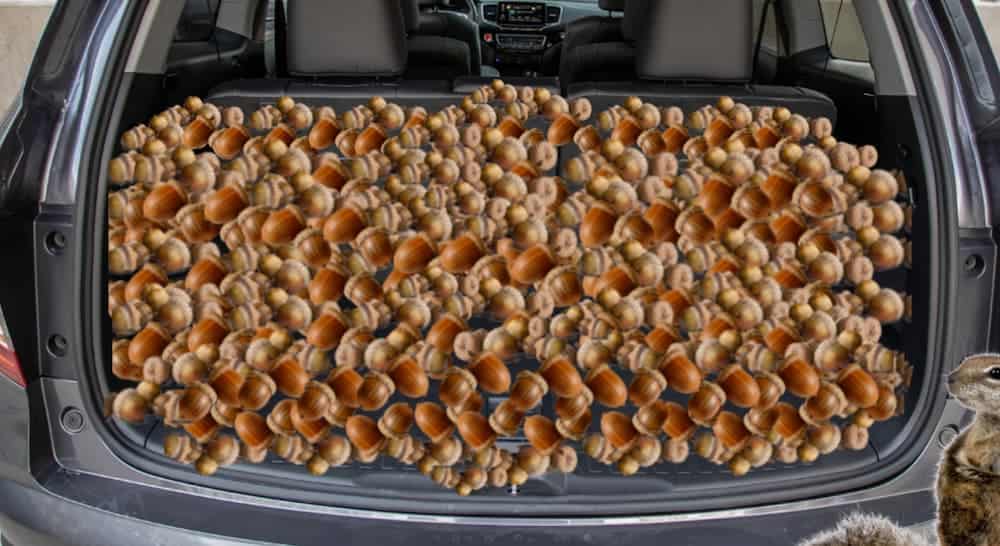I don’t know you, and you don’t know me, but if there’s anything I’ve learned from the extensive data we collect from you every time you visit our site, it’s this: you’re a squirrel. That’s right, based on our analytics, thorough metrics, and market research we have on file, 80-90% of my readership consists of squirrels. So today, I’m going to give you what you want: a comparison of the 2020 Chevy Traverse vs 2020 Honda Pilot with information you’ll find useful.
Because I understand you: my furry friends and loyal, tree-dwelling fans, you’re out there trying to do some research, typing away on your phone or keyboard as best you can with your little paws, hoping desperately to find some meaningful data on different vehicles. But again and again, all you encounter is a bunch of hogwash about “passenger volume” and “safety features.” What need have you of numerous rows of expansive seating? The squirrel folk are a hardy and robust people, small in size and stature but great in spirit, so you don’t care about passenger space.
Oh no, my friends, what you want is simple. And today, at long last, your tireless journey for the truth is at an end. Read on, and go in peace!
Interior Cargo Volume
First things first, let’s get some basic information out of the way so we can get to the good stuff––the meaty seed at the heart of this husky reality. What you want, what you really, really want, is to know how many seeds and other good things to eat you can load up into these two vehicles. That means cargo capacity––this tells you how much space you have inside for all the wondrous vittles you could want. These are both three-row vehicles, so we’ll look at space behind each row of seats.
The 2020 Chevy Traverse has 23 cu.ft. of cargo volume behind the third row of seats, about 58 cu.ft. of space behind the second row of seating, and more than 98 cu.ft. of total cargo volume behind the front row. Now, it’s likely that you’re not going to need those rear seats, so that final number is the one we really want. But, just in case you have some other stuff you need to take with you (perhaps a nice flower arrangement?), it’s worth noting what you get overall.
On the other hand, the 2020 Honda Pilot offers just 16 cu.ft. of cargo space behind the third row of seats, which you can easily see is substantially less than the 2020 Chevy Traverse has to offer. Behind the second row of seats, the Pilot has about 46 cu.ft. of cargo volume, still much less than the Traverse, and finally, the Honda model has about 83 cu.ft. of total cargo space behind the front row of seats. That’s a huge difference compared to the 2020 Chevy Traverse––about 15 cu.ft. But what does that really mean, really? Good news, my arboreal friend, we’re about to find out…
Some Acorn Info
As a squirrel trying to decide on which midsize SUV is right for you, you probably have just one thing in mind: maximum nut storage potential. I don’t blame you; when I look at a large SUV driving past me on the road, I typically wonder how many nuts it could fit too. So, let’s do some math and see what we can get. Please remember these are estimates and theoretical numbers only––don’t make your final decision strictly based on what follows, but it should inform your choice.
A typical acorn, depending on the species of tree it comes from, is about one inch in length, half that size in diameter across, and weighs about one gram. Now, there are about 1,700 cubic inches in a single cubic foot; just to be safe, we’ll assume a single acorn takes up one cubic inch––though it may take up less space than that. This means you can get about 1,700 acorns into a single cubic foot. You see where this is going?
Unbridled Acorn Potential
Since the 2020 Chevy Traverse offers up to about 98 cu.ft. of interior cargo space and knowing you can get around 1,700 acorns into one cu.ft. of space, this means you should be able to load more than 166,000 acorns into the Traverse! I’ll give you a moment to fully process that and stop chittering excitedly. Feeling better now? Good, let’s continue…
Now, one thing to consider is that all of those acorns have weight, and the Traverse does have a weight limit. The average weight of an eastern gray squirrel is between 0.88 and 1.3 lbs. We’ll estimate 1.0 lb. for each of you, and let’s imagine you and three of your squirrely buddies are loaded up in the front seat (hopefully none of you are too chunky): that’s 4 lbs of squirrel.
The 2020 Chevy Traverse has a curb weight of 4,362 lbs and a Gross Vehicle Weight Rating (GVWR) of 6,160 lbs leaving you with at most, 1,798 lbs to play with. Having 4 lbs of squirrel, you can load, let’s say 1,790 lbs of acorns into the Chevy Traverse. We said earlier that each acorn weighs about 1 gram, and there are about 453 grams in 1 lb. So, the Traverse can handle the weight of more than 810,000 acorns––giving you plenty of leeway for the 166,000 acorns that can fit inside.
Since we know the 2020 Honda Pilot has less room inside, we already know it can carry fewer acorns within it. If that’s enough for you, then feel free to move on. But if you’re an analytical squirrel (you know who you are), then let’s see how much of a difference we’re talking about.
With up to 83 cu.ft. of total cargo space available, the Pilot has room enough inside for a little over 141,000 acorns. The 2020 Honda Pilot has a curb weight of up to 4,306 lbs if you look at the Touring trim, with a GVWR of up to 5,842 lbs. That means it can handle the weight of up to 693,000 acorns, though obviously, it has room for far fewer within.
Let’s be fair: 141,000 acorns is a lot. But is it enough? Think about the cold, gray months of winter, when the world sleeps, and food is scarce. Are you going to be content with the meager smattering of nuts the Honda Pilot can afford you? Or do you need, nay deserve, the ample bounty of the 2020 Chevy Traverse, with its potential to store 25,000 more acorns than the Pilot?! Oh, my friend, the answer is clear.
So Much More!
It’s also worth pointing out that both of these vehicles have a maximum towing capacity of up to 5,000 lbs. Let’s say you get yourself a trailer that weighs 1,250 lbs and offers up to 230 cu.ft. of storage area. Are you ready for this? Even a 5×10 trailer with that kind of capacity would let you load up about 391,000 acorns. Nearly 400,000 additional acorns. Such glorious, mouth-watering potential…
Editor’s Note: Some would argue that squirrels are a niche automotive market, but our analytics are error-proof, and we know what we know. We hope you found the preceding information useful, and please feel free to send us your favorite recipes for candied chestnuts, hotroot soup, or deeper’n’ever turnip’n’tater’n’beetroot pie! Thank you.














